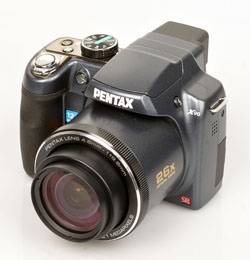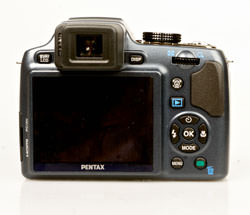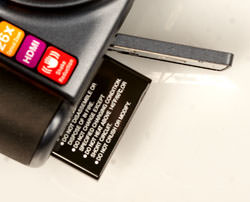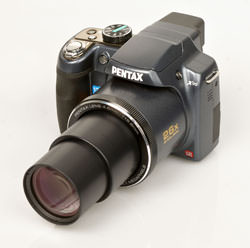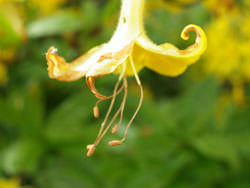Features
Handling
Performance
ePHOTOzine verdict and ratings
Specification
| Pentax Optio X90: Click on the thumbnail for the larger image. |
 |
| In this review, Gary Wolstenholme takes a look at Pentax’s latest flagship bridge camera. |
It seems the race to have the largest zoom lens on a bridge compact camera isn’t about to let up just yet. The Optio X90 from Pentax comes equipped with a whopping 26x optical zoom lens covering a range equivalent to 26-676mm on a 35mm camera in a reasonably compact and lightweight body. One of these cameras will set you back around £230, which doesn’t seem bad when the enormous zoom range is taken into consideration.
Pentax Optio X90: Features
The 26x zoom lens is obviously the lead feature of this camera, offering an amazing amount of flexibility of composition in a compact lightweight package. The lens covers a range equivalent to 26-676mm on a 35mm camera, which will provide quite a wide angle for when you have to shoot in a tight spot, and super-telephoto suitable for wildlife and action shots, where you can’t get close to the action.
Behind the lens lies a 12.1 megapixel CCD sensor, with CCD-shift stabilisation, which will be necessary to make the most of the huge zoom range on offer. The sensor also has a sensitivity range of ISO80-6400, which should make the camera suitable for low-light shooting, if the performance is up to the job.
A 2.7inch LCD screen with a resolution of around 230,000 dots and a electronic viewfinder with a resolution of around 200,000 dots are provided for composing and reviewing pictures. The EVF has a diopter adjustment dial on the side for easier viewing without spectacles. Saying that I found the EVF easy enough to use with my glasses.
High definition video clips at 720p resolution can be recorded and viewed on a compatible HD TV via the supplied HDMI output. The HDMI output will also allow pictures taken with the camera to be seen on a HD TV at higher resolution, leading to a more pleasant viewing experience.
Other features include a 1cm macro mode for shooting close to your subject, an improved battery and a raft of manual and automatic exposure modes, to keep those after simplicity or creativity happy.
Pentax Optio X90: Handling
Much of the Optio X90’s body is made from blue-coloured plastic with a slight metallic lustre to it. Personally, I’m not really a fan of the finish, although the materials used feel to be good quality.
The camera is very lightweight for such a huge zoom range, weighing only 428g with the battery and SD card installed. Due to the light weight, extra care needs to be taken when taking pictures at the telephoto end of the zoom as I did find it difficult to properly steady myself adequately. The image stabilisation system does help with this, but it still pays to be careful.
Rubberised plastic finger grips are provided to help attain a little more purchase on the camera body and as a result my grip on the camera feels very secure indeed. The finger grip on the front of the camera is quite shallow though, and will feel more comfortable to hold for those with smaller hands.
Pentax Optio X90: Performance
The exposure system the X90 is equipped with works very well in a wide range of conditions, especially when the face detection feature is active. In these situations the camera’s meter is very difficult to fool indeed. In contrasty scenes, the multi pattern metering system tends to produce bright exposures keeping detail in the shadows, at the expense of the highlights. This will mean shots of backlit subjects should be well exposed. In cases where they aren’t exposure compensation can be activated through a range of plus or minus two stops.
Colours tend to be rendered accurately by the X90, especially primary colours, which have just enough saturation for a punchy, vivid look, without overdoing things. Skin tones are reproduced accurately also.
In use I found the X90 to be reasonably responsive, especially at the shorter end of the zoom. There is a little noticeable shutter lag throughout the zoom, which can make shooting action quite tough, as you have to pre-empt each shot. As you zoom towards the telephoto end to the zoom range the autofocus slows down, taking a few seconds in some cases to achieve focus at maximum telephoto.
ISO and noise performance
Noise performance with the X90 is typical of many other compact CCD based digital cameras, with images up to ISO200 showing no significant signs of noise. At ISO400 the softening effects of noise reduction can be seen on fine detail, even though the levels of noise still appear quite low. This trend continues, with each ISO setting showing increasing levels of noise and softening due to noise reduction, although images at ISO800 should still be suitable for postcard size prints. Beyond this setting the snowy appearance starts to take over and colour saturation suffers due to the camera’s attempts to reduce coloured speckles in images. Images taken at ISO3200 and ISO6400 should still be suitable for sharing on the web at small sizes though.
White-balance
When shooting under incandescent light, the X90’s auto white balance seems to perform quite well, leaving only a slight colour cast in images. Under the same conditions the incandescent preset also performs very well, producing very accurate colour. Under the warm white fluorescents in our studio, the auto white balance system performs less well, leaving a very strong amber cast in images. The fluorescent preset perms better in this case, but there is still quite a noticeable magenta cast in images.
Buffer read/write times
I recorded a delay from shot to shot in single shot mode of 2.8 seconds on average when using a class 6 SDHC card, which is pretty typical for a camera of this type. Although this isn’t too disappointing a result, those wishing to use the camera to record fast action may find this delay a little frustrating.
Lens performance
In general, the 26x zoom lens appears to perform well, producing images that are sharp from edge to edge. Due to the massive zoom range distortion can be quite noticeable. At the wide end barrel distortion is prevalent, which may pose issues when photographing subjects with straight lines, such as architecture.
The lens appears to be quite resistant to flare and ghosting and only slight amounts of chromatic aberration are visible in extreme contrast situations. A 1cm macro mode is very useful for close-ups, allowing items to be almost touching the front element of the lens. This macro ability is only available at the wide end of the zoom though, so subject magnification isn’t that high.
Pentax Optio X90: Verdict
A zoom range of this level is certainly an interesting prospect and will definitely suit those looking for that kind of flexibility, while being able to travel light. The camera performs well, producing images with good clarity at sensitivities of ISO200 or lower. Given the huge telephoto at your disposal it would’ve been nice if the camera performed better at higher sensitivities though.
Overall, it is a very interesting camera, that works well, but does have it’s weaknesses, such as the ISO performance at high sensitivities, slow autofocus at the telephoto end and barrel distortion at the wide end of the zoom range.
If however the light weight and flexibility outweigh those weaknesses for you, then this camera is certainly worth a look.
Pentax Optio X90: Pros Light weight
Light weight Enormous zoom range
Enormous zoom range Generally accurate exposure system
Generally accurate exposure system Clarity at lower sensitivities
Clarity at lower sensitivities Image stabilistion
Image stabilistion
Pentax Optio X90: Cons Quality it higher sensitivities
Quality it higher sensitivities Barrel distortion at wide end of zoom range
Barrel distortion at wide end of zoom range  Slow AF at telephoto end
Slow AF at telephoto end White balance performance under fluorescent light
White balance performance under fluorescent light
Pentax Optio X90: Specification
| Price | £220.00 |
| What comes in the box | AV cable, USB cable, AC cord, Li-ion rechargeable battery, battery charger, strap, lens cap and Arcsoft Media Impression 2.0 for PENTAX software |
| Contact | www.pentax.co.uk |
| Lens | 4.6 – 119.6mm f/2.8 – 5.0 (approx. 26 – 676mm in 35mm format) |
| Resolution | 12.1Mp |
| Sensor size | 1/2.33inch |
| Sensor type | CCD |
| Max. Image size | 4000 x 3000 |
| Aspect ratio | 4:3 |
| LCD monitor size | 2.7 inch |
| Electronic viewfinder | approx. 200K dots |
| Focusing system | Contrast detection |
| Focusing modes | 9-point AF, Spot AF, Auto tracking AF Infinity-landscape, Manual Focus, AF Point switching |
| File types | JPEG |
| ISO sensitivity | ISO80-6400 |
| Metering system | Multi-segment metering, Center-weighted metering, Spot metering |
| Metering modes | Programs: AutoPicture, Movements, Anti-shake, Movie, USER, Manual, Av, Tv, P Scene modes: Auto Picture, Sport, Digital SR, Movie, Manual, User, Aperture Priority, Shutter Priority, Program, Landscape, Flower, Portrait, Backlight, Half-length Portrait, Night scene, Night scene Portrait, Stage Lighting, Surf & Snow, Baby, Kids, Pet, Food, Fireworks, Frame Composite, Party, Museum, Sunset, Digital Wide, Digital Panorama, Green |
| White-balance | Auto, Daylight, Shade, Tungsten light, Fluorescent light (W, D, N), Manual setting |
| Exposure compensation | +/- 2EV |
| Shutter speed range | 1/4000 – 1/4 sec. 4 sec at most (Tv, Av, M, Night Scene mode setting) |
| Anti-shake mode | CCD Shift Shake reduction |
| Movie mode | HDTV (1280×720), 15/30fps, VGA (640×480) 15/30fps, QVGA (320×240), 15/30 fps |
| Media type | SD, SDHC |
| Interface | USB, HDMI |
| Power | Rechargeable D-LI106 Lithium-ion battery |
| Size (wxdxl) | 84.5 x 111 x 110mm |
| Weight (with battery) | 428g |
The Pentax Optio X90 costs £230 and is available from Warehouse Express here:
